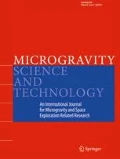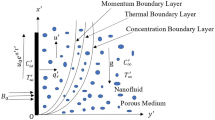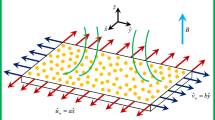Abstract
Numerical simulations are carried out to investigate the crystallization process of a protein macromolecular substance under two different conditions: pure diffusive regime and microgravity conditions present on space laboratories. The configuration under investigation consists of a protein reactor and a salt chamber separated by an “interface”. The interface is strictly related to the presence of agarose gel in one of the two chambers. Sedimentation and convection under normal gravity conditions are prevented by the use of gel in the protein chamber (pure diffusive regime). Under microgravity conditions periodic time-dependent accelerations (g-jitter) are taken into account. Novel mathematical models are introduced to simulate the complex phenomena related to protein nucleation and further precipitation (or resolution) according to the concentration distribution and in particular to simulate the motion of the crystals due to g-jitter in the microgravity environment. The numerical results show that gellified lysozyme (crystals “locked” on the matrix of agarose gel) precipitates to produce “spaced deposits”. The crystal formation results modulated in time and in space (Liesegang patterns), due to the non-linear interplay among transport, crystal nucleation and growth. The propagation of the nucleation front is characterized by a wavelike behaviour. In microgravity conditions (without gel), g-jitter effects act modifying the phenomena with respect to the on ground gellified configuration. The role played by the direction of the applied sinusoidal acceleration with respect to the imposed concentration gradient (parallel or perpendicular) is investigated. It has a strong influence on the dynamic behaviour of the depletion zones and on the spatial distribution of the crystals. Accordingly the possibility to obtain better crystals for diffraction analyses is discussed.
Similar content being viewed by others
7. References
Ramachandran N., Baugher Ch. R., Naumann R.J., “Modeling flows and transport in protein crystal growth,”, Microgravity sci. technol. Vol. VIII/3, p. 170 (1995)
Qi J., Wakayama N. I., “Solute convection during the whole process of protein crystal growth”, J. Cryst. Growth, Vol. 219, p. 465, (2000).
Otàlora F., Novella M. L., Gavira J. A., Thomas B. R., Garcìa-Ruiz J.M., “Experimental evidence for the stability of the depletion zone around a growing protein crystal under microgravity”, Acta Crys., Vol. D57, p. 412, (2001).
Pusey M. L., Snyder R. S., Naumann R., “Protein crystal growth: growth kinetics for tetragonal lysozyme crystals”, Journal of Biological Chemistry, Vol. 261 No. 14, p. 6524, (1986).
Monaco A., Rosenberger F., “Growth and etching kinetics of tetragonal lysozyme”, J. Cryst. Growth, Vol. 129, p. 465, (1993).
Kuznetsov Yu G., Malkin A. J., Greenwood A., McPherson A., “Interferometric studies of growth kinetics and surface morphology in macromolecular crystal growth: canavalin, thaumatin and turnip yellow mosaic virus”, Journal of structural biology, Vol. 114, p. 184, (1995).
Coriell S. R., Chernov A.A., Murray B.T., McFadden G.B., “Step bunching: generalized kinetics”, Journal of Crystal Growth Vol. 183, p. 669, (1998).
Otàlora F., Garcìa-Ruiz J.M., “Crystal growth studies in microgravity with the APCF: Computer simulation and transport dynamics”, Journal of Crystal Growth, Vol. 182, p. 141, (1987).
Henisch H.K., Garcà-Ruiz J.M., “Crystal growth in gels and Liesegang ring formation: Crystallization criteria and successive precipitation”, Journal of Crystal Growth, Vol. 75, p. 203, (1986).
Henisch H. K., “Periodic Precipitation: a microcomputer analysis of transport and reaction processes in diffusion media with software development”, Pergamon Press, (1991).
Galkin O., Vekilov P. G., “Direct determination of the nucleation rates of protein crystals”, J. Phys. Chem. B, Vol. 103, p. 10965, (1999).
Monti R., Langbein D., Favier J.J., “Influence of residual accelerations on fluid physics and material science experiments”, in Fluid and material Science in Space, H.U. Walter ed., (1987).
Mc Fadden G.B., Coriell S.R., “Solutal convection during directional solidification”, AIAA paper 88-3635-CP, (1988).
Schneider S., Straub J., “Influence of the Prandtl number on laminar natural convection in a cylinder caused by g-jitter”, J. Crystal Growth, Vol. 46, p. 125, (1989).
Alexander J.I.D., “Low gravity experiment sensitivity to residual acceleration: a review”, Microgravity Sci. and Tech., Vol. 3, p. 52, (1990).
Ramachandran N., “G-jitter convection in enclosures”, 9th International Heat Transfer Conference, paper 8-MC-03, Jerusalem, Israel (August 1990)
Monti R., Savino R., “The basis and the recent developments of OMA and its applications to microgravity”. Microgravity Quarterly Vol. 5, No.1, p. 13, (1994).
Monti R., Savino R., “A new approach to g-level tolerability for Fluid and Material Science experiments”. Acta Astronautica Vol. 37, p. 313, (1994).
Monti R., Savino R., “Influence of g-jitter on fluid physics experimentation on-board the International Space Station”. ESA SP-385, p. 215, (1996).
Monti R., Savino R., “Microgravity experiment acceleration tolerability on space orbiting laboratories”, Journal of Spacecraft and Rockets Vol. 33, No.5, p. 707, (1996).
Savino R., Monti R., “Convection induced by residual-g and g-jitters in diffusion experiments”, Int. J. Heat and Mass Transfer Vol.42, p. 111, (1999).
Gershuni G.Z., Zhukhovitskii E.M., Yurkov Yu. S., “Vibrational thermal convection in a rectangular cavity”, Izv. Akad. Nauk SSSR Mekh. Zhidk. Gaza Vol. 4, p. 94, (1982).
Lappa M.; “Strategies for parallelizing the three-dimensional Navier-Stokes equations on the Cray T3E”; Science and Supercomputing at CINECA, M. Voli Editor, Bologna, p. 326, (1997).
Piccolo C., Lappa M., Tortora A., Castagnolo D., Carotenuto L., “Nonlinear behaviour of lysozyme crystallization”, Physica A: Statistical Mechanics and its Applications Vol. 314, No. 1–4, p. 636, (2002).
Lappa M., Castagnolo D., Carotenuto L., “Sensitivity of the non-linear dynamics of lysozyme ‘Liesegang Rings’ to small asymmetries”, Physica A: Statistical Mechanics and its Applications Vol. 314, No. 1–4, p. 623, (2002).
Author information
Authors and Affiliations
Corresponding author
Rights and permissions
About this article
Cite this article
Lappa, M., Carotenuto, L. Effect of convective disturbances induced by g-jitter on the periodic precipitation of lysozyme. Microgravity Sci. Technol 14, 41–56 (2003). https://doi.org/10.1007/BF02870315
Received:
Revised:
Accepted:
Issue Date:
DOI: https://doi.org/10.1007/BF02870315




